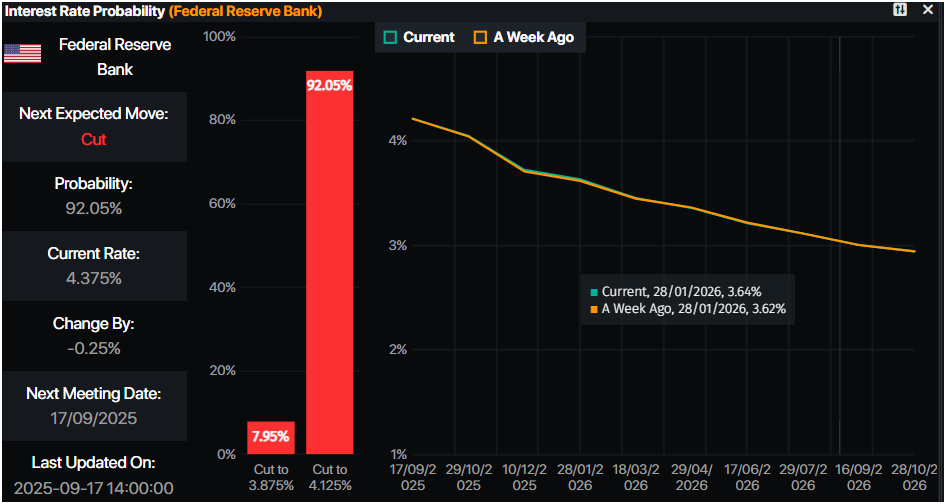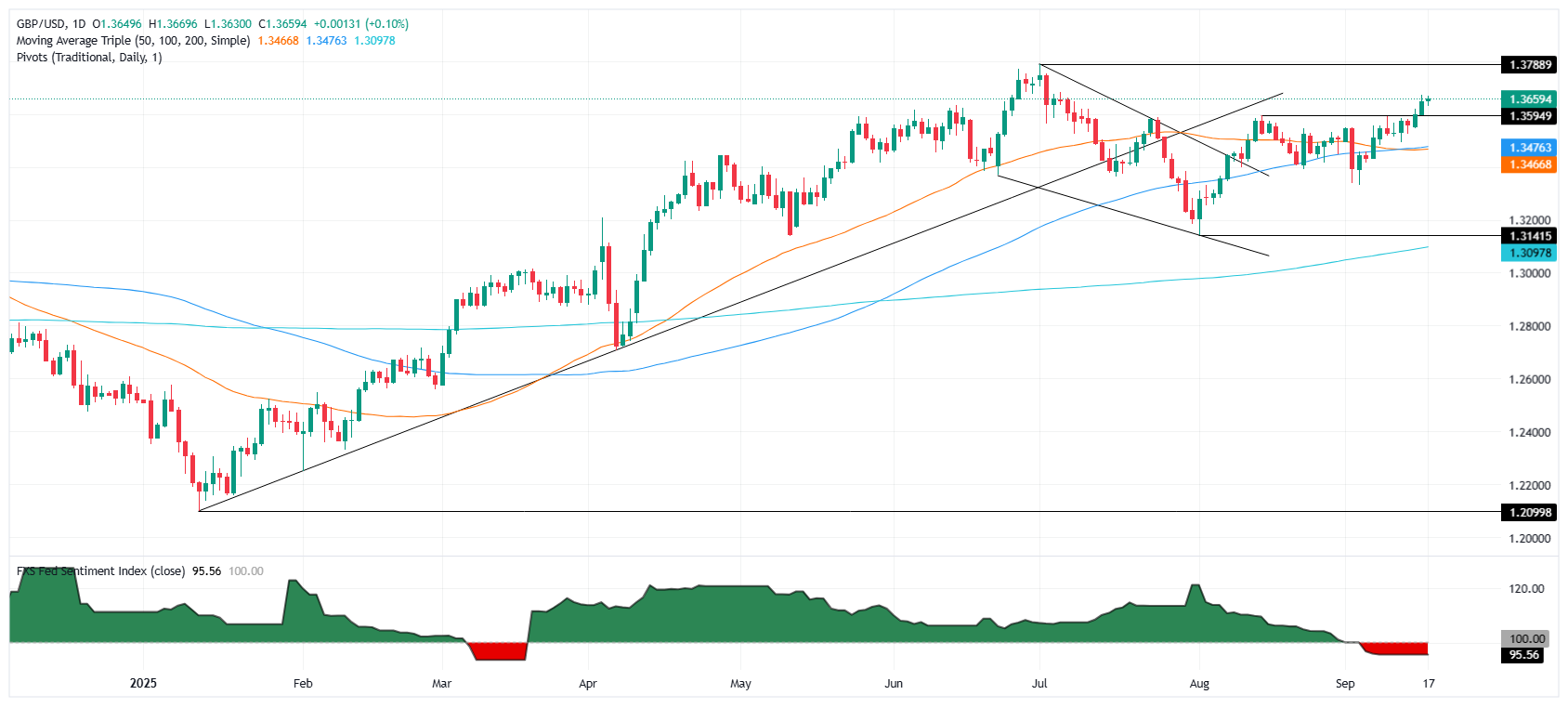Created
: 2025.09.17














![]() 2025.09.18 00:01
2025.09.18 00:01
The British Pound advances modestly 0.15% on Wednesday as traders await the outcome of the Federal Reserve's (Fed) monetary policy decision. Nevertheless, Sterling climbs as inflation data in the UK, justifies the Bank of England's (BoE) stance of holding rates on Thursday. The GBP/USD trades at 1.3661 after bouncing off daily lows of 1.3629.
Later, the Fed is expected to reduce rates by 25 basis points (bps) to the 4.00%-4.25% range as expected by analysts. The decision is not expected to be unanimous, as Trump's appointee Stephen Miran could push for a 50-basis point cut.
TD Securities on a note said that Powell "is unlikely to commit to the future path of rate cuts," which would mean that subsequent meetings would be live, keeping the Fed options open in the event of a reacceleration of inflation.
Market participants will also review the updated Summary of Economic Projections (SEP) and the "dot plot" for insight into the future of interest rate's path.
Earlier, US Housing Starts in August fell, hitting its lowest level since May. Starts plunged -8.5% MoM after an increase of 5.2% in July, dropped from 1.428 million to 1.307 million. Building Permits also decreased by -3.7%.
Across the pond, August's inflation in the UK came aligned with estimates at 3.8% YoY. Core CPI cooled from 3.8% to 3.6% YoY, and both reported readings were aligned with the BoE's latest projections. This data cemented the case for the BoE to hold rates unchanged at 4% on Thursday. Nevertheless, a Reuters poll revealed that economists expect at least one more reduction in 2025.

Source: Prime Market Terminal
The GBP/USD technical picture remains bullish, though traders will face key resistance at 1.3681, the July 4 peak. A breach of the latter will expose the 1.3700 figure, ahead of challenging the yearly peak at 1.3788. Overhead lies 1.3800.
Conversely, if GBP/USD drops below1.3650, sellers could drive prices towards 1.3600, and test the September 16 low at 1.3592. On further weakness, the 20-day SMA could be tested at 1.3516.

Monetary policy in the US is shaped by the Federal Reserve (Fed). The Fed has two mandates: to achieve price stability and foster full employment. Its primary tool to achieve these goals is by adjusting interest rates. When prices are rising too quickly and inflation is above the Fed's 2% target, it raises interest rates, increasing borrowing costs throughout the economy. This results in a stronger US Dollar (USD) as it makes the US a more attractive place for international investors to park their money. When inflation falls below 2% or the Unemployment Rate is too high, the Fed may lower interest rates to encourage borrowing, which weighs on the Greenback.
The Federal Reserve (Fed) holds eight policy meetings a year, where the Federal Open Market Committee (FOMC) assesses economic conditions and makes monetary policy decisions. The FOMC is attended by twelve Fed officials - the seven members of the Board of Governors, the president of the Federal Reserve Bank of New York, and four of the remaining eleven regional Reserve Bank presidents, who serve one-year terms on a rotating basis.
In extreme situations, the Federal Reserve may resort to a policy named Quantitative Easing (QE). QE is the process by which the Fed substantially increases the flow of credit in a stuck financial system. It is a non-standard policy measure used during crises or when inflation is extremely low. It was the Fed's weapon of choice during the Great Financial Crisis in 2008. It involves the Fed printing more Dollars and using them to buy high grade bonds from financial institutions. QE usually weakens the US Dollar.
Quantitative tightening (QT) is the reverse process of QE, whereby the Federal Reserve stops buying bonds from financial institutions and does not reinvest the principal from the bonds it holds maturing, to purchase new bonds. It is usually positive for the value of the US Dollar.
![]()
Created
: 2025.09.17
![]()
Last updated
: 2025.09.18

FXStreet is a forex information website, delivering market analysis and news articles 24/7.
It features a number of articles contributed by well-known analysts, in addition to the ones by its editorial team.
Founded in 2000 by Francesc Riverola, a Spanish economist, it has grown to become a world-renowned information website.
We hope you find this article useful. Any comments or suggestions will be greatly appreciated.
We are also looking for writers with extensive experience in forex and crypto to join us.
please contact us at [email protected].
Disclaimer:
All information and content provided on this website is provided for informational purposes only and is not intended to solicit any investment. Although all efforts are made in order to ensure that the information is correct, no guarantee is provided for the accuracy of any content on this website. Any decision made shall be the responsibility of the investor and Myforex does not take any responsibility whatsoever regarding the use of any information provided herein.
The content provided on this website belongs to Myforex and, where stated, the relevant licensors. All rights are reserved by Myforex and the relevant licensors, and no content of this website, whether in full or in part, shall be copied or displayed elsewhere without the explicit written permission of the relevant copyright holder. If you wish to use any part of the content provided on this website, please ensure that you contact Myforex.
Myforex uses cookies to improve the convenience and functionality of this website. This website may include cookies not only by us but also by third parties (advertisers, log analysts, etc.) for the purpose of tracking the activities of users. Cookie policy